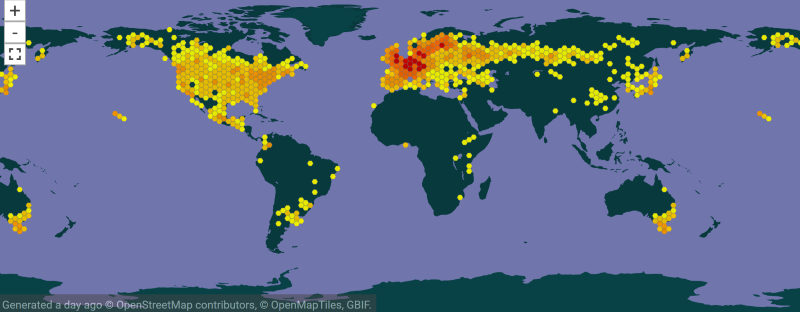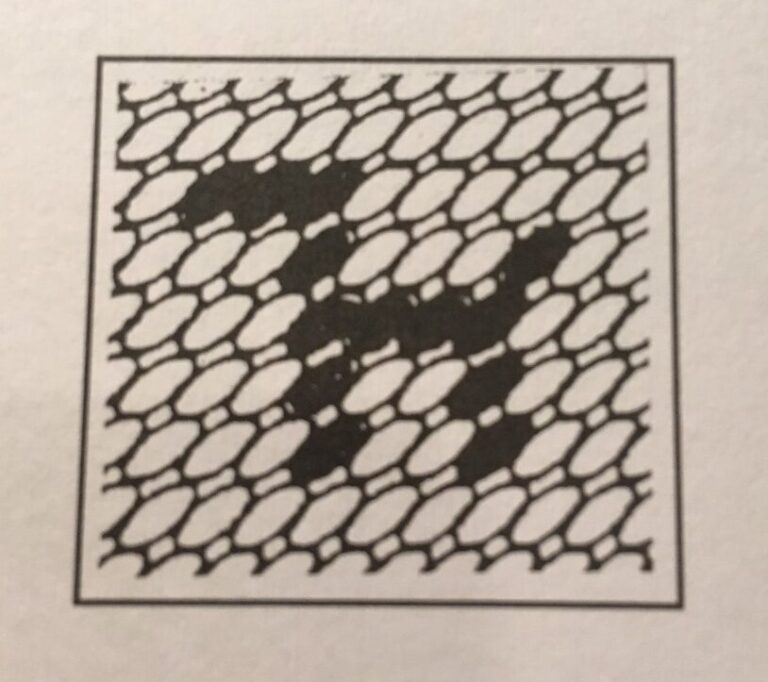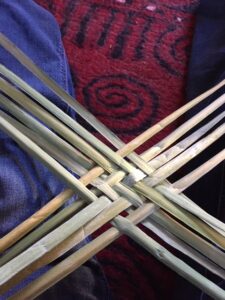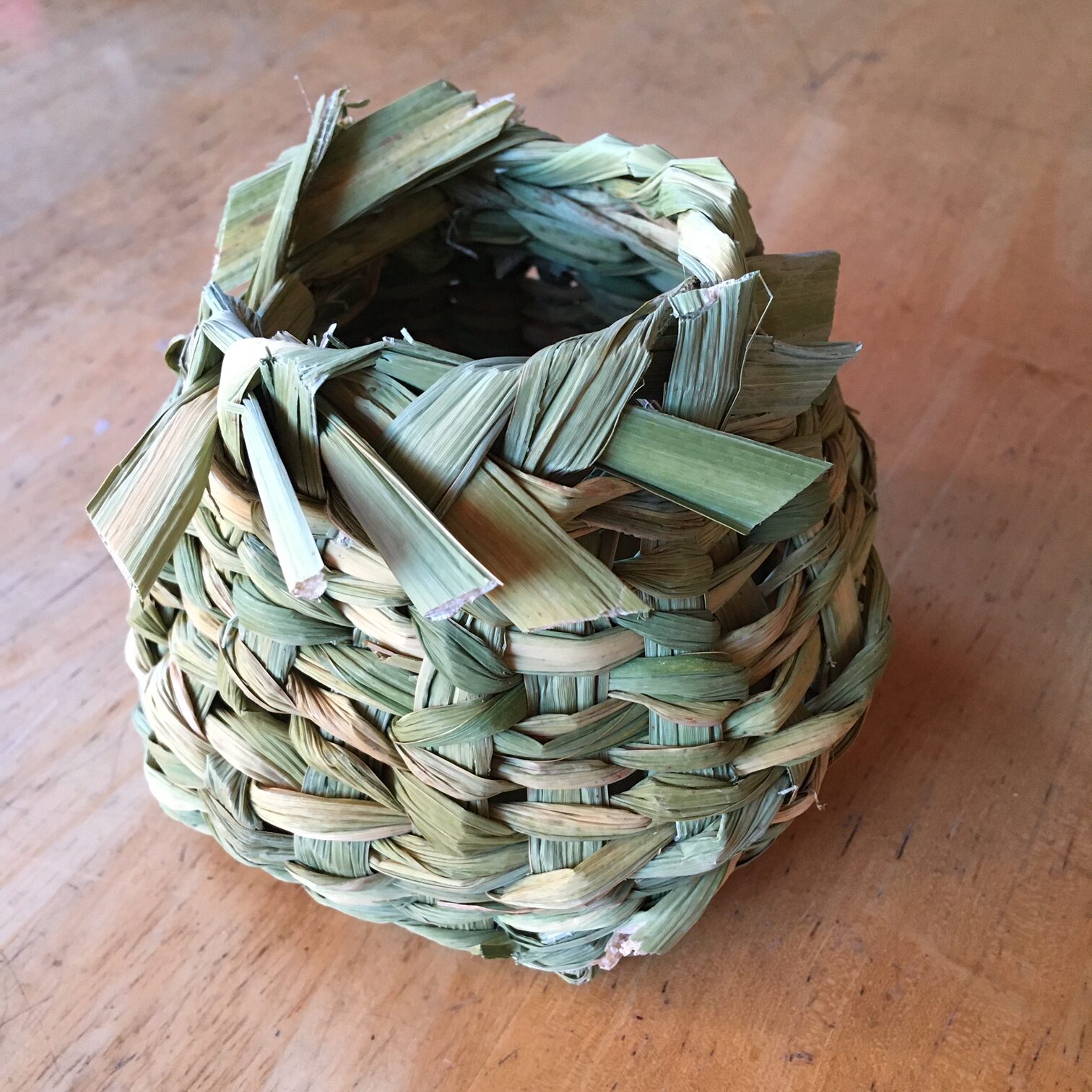Cattails
There are three species of cattails in the family Typhaceae growing in North America. Of these three species, only Typha latifolia L., or the broad-leaved cattail, is found in Alaska. Worldwide, cattails are an important resource in almost all of the communities where they grow, and there is an astonishing amount of information about the plant in the literature. I found citations of people eating all parts of the plants, from making flour out of the yellow pollen or ground roots, to eating the fresh sprouts in the spring. I also found records of people making things from all parts of the plants, from insulation for the walls of winter houses made of leaves, to using the pollen “fluff” as tinder, and the ashes for tattooing. For this project, I am limiting my focus to the use of cattails in making baskets. Turner and Bell state, “This was probably the most important basket and mat weaving material of the Island Salish. For basket-weaving, the leaves were split and spun on the bare thigh. Camas bulbs and crabapples were commonly stored in the bags made of cattail leaves” (Turner and Bell, 1971, p. 71). Not only are baskets functional, but they have value in beauty and ceremony too, often given as gifts.
Although cattail use in Alaska is listed in numerous resources, mainly in mat-making, I did not find any Alaska Native names for cattails. Before moving on to the distribution information, I wanted to share a myth I found of cattails being responsible for the creation and distribution of people. There are many such myths, and I like stories that explain the importance of relationship. According to a Washoe legend, “Cattail seeds were turned into people; some became Miwok, others became Paiute, and still others became Washoe. These myths instruct humans that plants and people are from the same source and are related” (Anderson, 2005, p. 249).
T latifolia is a cosmopolitan species, with its native range encompassing large regions on all continents, except Antarctica, Africa and Oceania, and it grows in a wide variety of wetland habitats. Niches include marshes, wet meadows, lakeshores, roadside ditches, seacoast estuaries, pond margins, bogs or fens as well as rice paddies.

Processing Material – PRE-HARVEST
“Traditional relationships with plants include asking permission to harvest and being grateful for the opportunity to gather and tend plants in the area” (Stevens, 2004, p. 8). “For example, John Ross (2011, 248) describes a special ceremony preceding the actual cutting and gathering of cattail and tule by Spokan women: “this ritual was led by an elderly woman who was recognized as being the most knowledgeable of such harvest, and, prior to cutting and gathering, she would give an oration of gratitude for the resources as well as recognize the presence of all the women in attendance” (Turner, 2014, p. 333). For as long as I have been gathering plants for food or materials, I have engaged in varied rituals to express respect for the land, ask permission to gather, and honor the people and plants who/that have taught me the skills to identify plants correctly, to harvest sustainably, and to prepare with joy – to appreciate my connection.
Processing Material – HARVEST

In everything I read, I found almost 100% agreement about the fundamental processing of the material. The leaves are cut just above the water level or just above the base, leaving the roots in the ground to produce more stalks. Of note, cattail “stalks without catkins, termed females in Puget Sound languages, although they are botanically the males, have softer cores and less rounded leaves” (Thompson and Marr, 1983, p. 21). After cutting, the leaves are either spread out or hung in bundles and left to dry for weeks. And, for making baskets, I only found cattails used in twined basketry, not in coiled or plaited basketry. The difference is in the details, and that defined my project.
Though the leaves are cut in the same place, they are not all cut at the same time, or season, of the year. Overwhelmingly, weavers cut the leaves during the summer while they are still green. However, one source stated, “Both tule and cattail were considered better if harvested in fall, after a “killing frost”, which caused them to turn a dark, mottled brown colour, rather than being used green” (Turner, 2014, p. 346). Another source mentions, “…and those found near the saltwater were felt to be the strongest” (Thompson and Marr, 1983, p. 22). With that in mind, I harvested one summer green bundle, and one fall brown bundle, both from saltwater, and left them to dry for several weeks in a cool, dry location.
Processing Material – WEAVING

I am an avid knitter, and episodic weaver. When I am knitting or weaving, I like to think of the recipient, and time we spent together. The summer trip to my friend’s “duck shack” in Rabbit Slough was very special. We took Panthea, who is struggling with cancer, (and is a kindred spirit botanist), on a safe outing during a difficult isolation. She and I were talking about a story I read in one of my resources for this project, a children’s book about basketry and a Skokomish family; it said, “Only women could own those little woolly dogs. The women would spin the dog’s wool into yarn” (McNutt and Miller, 2011, p. 10). In addition to using the hair from the now extinct dogs for blanket-making, the Skokomish use the woolly dogs as a design element in their baskets. Since we had a small woolly dog on the trip, Buffy, I decided to include “her” in the design for Panthea.
But first I needed to explore the materials. I was glad to read that cattails are considered to be a good material for young Twana beginners, and also for elders since they are soft and pliable, and weaving with them does not require the same hand strength required to weave with roots (Thompson and Marr, 1983, p. 22). I was curious to find out whether there would be a difference between the green and brown cattails. Sort of like a test swatch for a knitting project, I made two test baskets, one out of green cattails, and one out of brown cattails. For both baskets, I wrapped the cattails in a wet blanket for a half-hour ahead of time, and while I was weaving, I would spritz them with water if it felt like they were getting dry, or if they started to crack or split. I used a pattern I was familiar with to weave a quick and simple bottom, and then used single twining for the sides.






And there were differences. The green cattails were plenty strong when I used them for wefts, or the weavers, but, as warps, or the spokes of the basket, they broke, a lot, and I had a hard time keeping the basket columnar as a result of the warps breaking and continually needing to be replaced. As weavers, they worked well until I got to the ends, then the strands would start to shred a little. The solution was to cut them off a little lower, in the thicker part of the cattail. Also, I really loved their green color!
The brown cattails, harvested after the first frost, while not dark, mottled brown as described in the account that I read, were extremely strong: it did not matter if they were warps or wefts, they held up equally well for both uses. The texture was nice too, instead of feeling like a reedy cattail like the green ones, they were soft, almost felt like velvet. The experiment with the materials taught me how to design the basket for Panthea. I decided to use the brown cattails for warps and the decorative woolly dog, and to use the green cattails for the weavers on the sides of the basket. It seems like my instinct to use the brown and green cattails for different roles is standing up to the test of weaving the gift. I might not finish the basket within the time-frame of this course, but wanted to share my progress to date.
Update: I finished weaving the basket! The woolly puppy is not nearly as distinct as I would like. I might try a second basket, and use the greenest weavers for the sides of the basket, and the darkest brown cattails for the puppy.


All photos taken by author unless otherwise noted/
References
Anderson, M. K., (2005). Tending the Wild: Native American Knowledge and Management of California’s Natural Resources. University of California Press
Distribution Map retrieved from https://www.gbif.org/species/5289423 on December 3, 2020
McNutt, N. and, Miller, B.S. (2011). The Twined Basket; A Native American Art Activity Book. West Winds Press
Stevens, M.L. (2004). Ethnoecology of selected California Wetland Plants. Fremontia 32(4):7-15. Retrieved from https://cnps.org/wp-content/uploads/2018/03/Fremontia_Vol32-No4.pdf
Thompson, N. and Marr, C. (1983) Crow’s Shells: Artistic Basketry of the Puget Sound. Dushuyay Publications
Turner, N.C. and Bell, M.A.M. (1971). The Ethnobotany of the Coast Salish Indians of Vancouver
Island, I and II. Economic Botany 25(1):63-104. Retrieved from: https://www.jstor.org/stable/4253212
Turner, N.J. (2014). Ancient Pathways, Ancestral Knowledge: Ethnobotany and Ecological Wisdom of Indigenous Peoples of Northwestern North America. McGill-Queen’s University Press
Posted: October 2020, updated December 2020.



